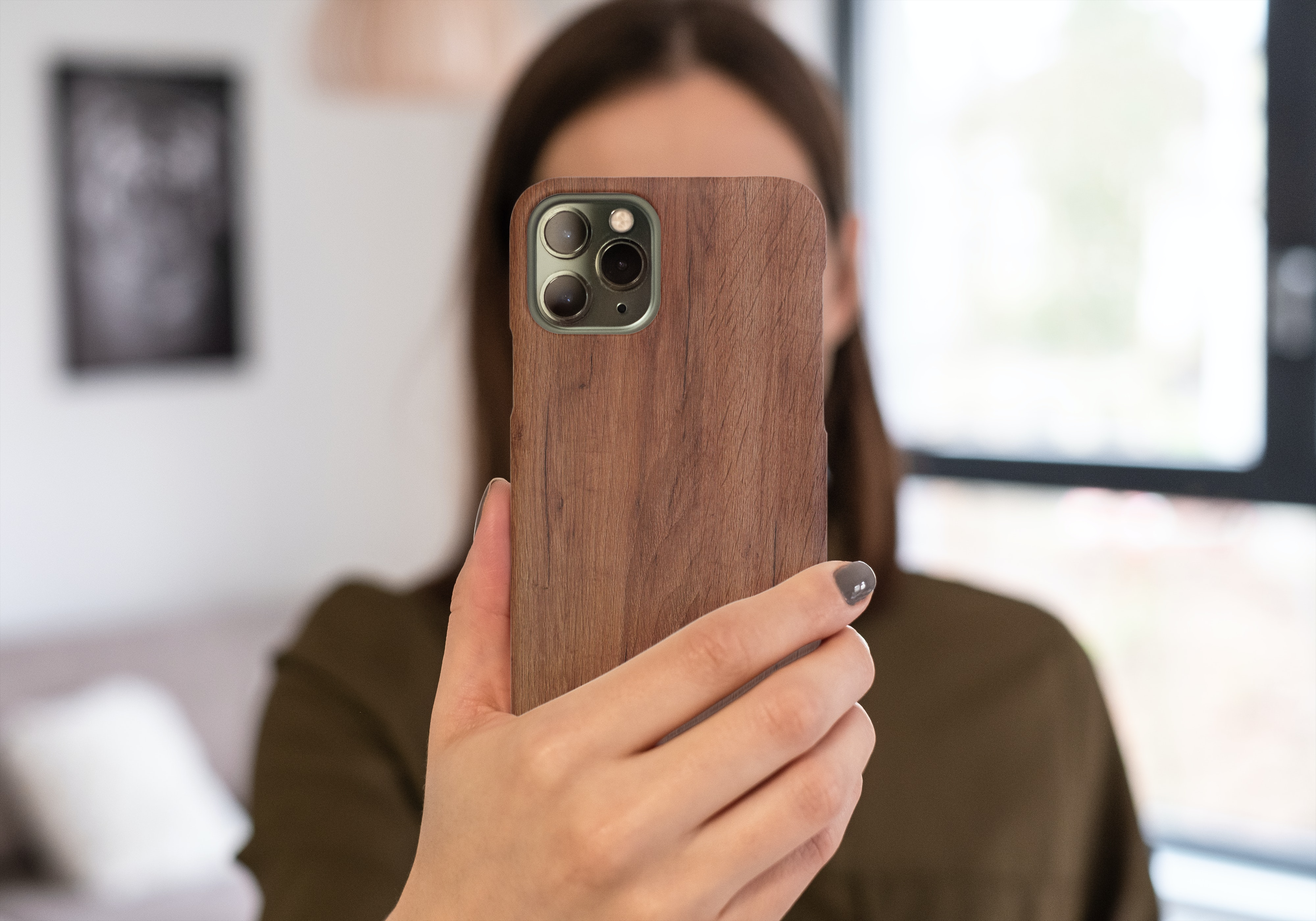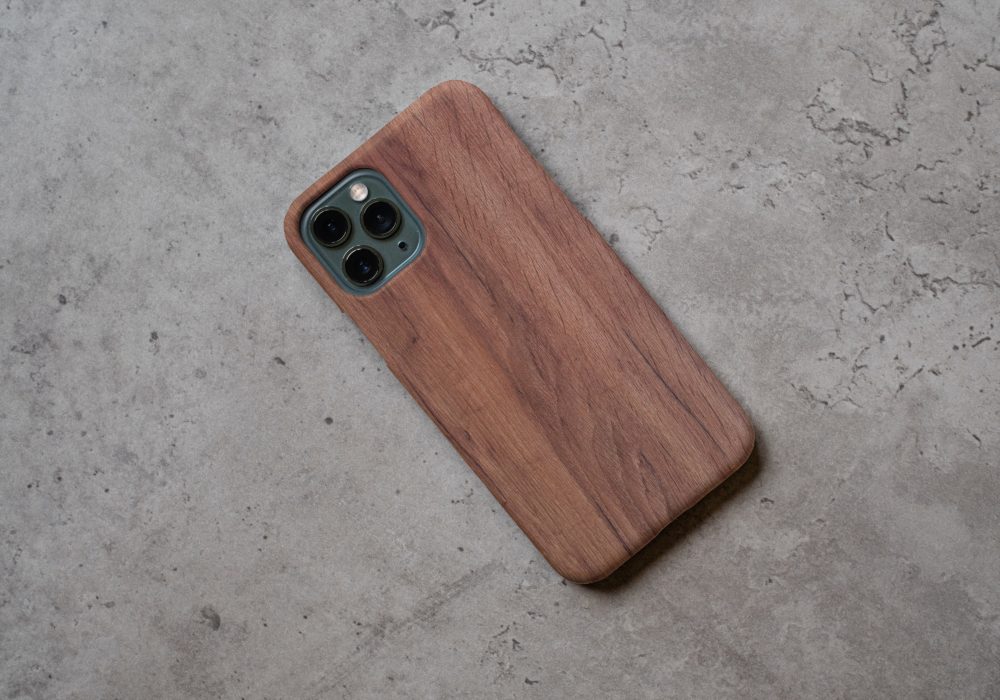Smartphone cases are available in all kinds of variations – the market is full of them. Now the trend has come to smartphone covers made out of wood.
The apparent advantages such as a unique design or ecological sustainability are obvious. Wood not only delivers a certain level of aesthetics, but is also a renewable and natural raw material – in contrast to plastic.
But what are the important characteristics of a phone case made of wood? What are the advantages, disadvantages and differences from other materials such as silicone, plastic or metal? Can a wooden smartphone case be used with inductive chargers? Which type of wood is the most suitable based on its characteristics?
This article is dedicated to the most important questions about wooden smartphone cases.
Wood & Co. – Characteristics of materials in comparison
The central question is how cell phone cases made of wood differ from other materials. Furthermore, not all wood is the same. Hardly any other material has so many different types with different attributes.
For comparability, we must first consider what aims are to be achieved with a cell phone cover. The protection against scratches as well as the protection against damages caused by dropping, such as cracks in the display, are central. These goals are achieved through the properties of hardness (protection against scratches) as well as a certain degree of elasticity of the material (protection against drop damage). These two qualities are examined in more detail below.
Hardness
The hardness of a material describes its resistance to surface damage. Hard materials are therefore well suited to protect a smartphone from sharp objects, scratches or other damage. Furthermore, the harder the material, the better the surface of the case itself remains in good condition. Wood, for example, is superior to cell phone cases made of silicone or rubber, since they can be damaged more easily by sharp or pointed objects, such as paper clips or coins in the pants pocket.
There are differences in the hardness and resistance to surface impact of wood types, which are compared in the following table:
| Woodtype (selection) | Hardness (bulk density Æ at 0% humidity) |
| Fir | very soft (410 kg/m³) |
| Spruce | very soft (470 kg/m³) |
| Pine | soft (520 kg/m³) |
| Douglas fir | medium hard (550-580 kg/m³) |
| Larch | medium hard (550-590 kg/m³) |
| Cherry | medium hard to hard (600 kg/m³) |
| Walnut | hard (640 kg/m³) |
| Oak | hard (650 kg/m³) |
| Ash | hard (650-690 kg/m³) |
| European beech | very hard (720 kg/m³) |
(Source: OBI Redaktion, 2022)
Elasticity
In the case of falls, however, it is not only the hardness of a material that is crucial. If an object falls to the ground, it absorbs the kinetic energy of the fall, which can damage it.
The key word here is elasticity.
If a smartphone is protected by a stretchy, elastic cover made of a flexible material, the cover is able to take up a part of the kinetic energy of the fall and convert it into deformation energy. As a result, the smartphone is better protected from fall damage.
However, if a smartphone is protected by a very hard, tight-fitting cover made of a stiff material, the cover can hardly absorb any kinetic energy and transfers a large part of it to the smartphone, which can be damaged as a result.
This phenomenon of deformation of materials is technically measurable by the Young’s modulus.
The Young’s modulus is a material index used in the field of materials technology. It describes the correlation between strain and stress during the deformation of solid objects with linear elastic behavior. The Young’s modulus has a greater value the more resistance the material shows to deformation. A high Young’s modulus (steel) thus has a higher stiffness than an identically designed component that has a low Young’s modulus (plastic). The following table shows an overview of the Young’s moduli of different materials:
| Material | Young’s modulus [kN/mm²] |
| Softwood (e.g. category C16 DIN 4074) | 8.0 |
| Hardwood (e.g. category C30 DIN 4074) | 12.0 |
| Plastic, PVC (Polyvinylchlorid) | 1.0 – 3.5 |
| Plastic, PP (Polypropylen) | 1.5 |
| Hard Rubber | 5 |
| Steel | 210.0 |
| Copper | 115.0 |
(Source: Wissenwiki and Wikipedia, 2022)
Can I use a wooden smartphone case with inductive/wireless charging?
Many smartphones nowadays support inductive charging (QI charging), i.e. charging the phone without a cable on a suitable charging station.
Does a wooden cell phone cover interfere with inductive charging?
No, a wooden phone case can be used with inductive charging without any problems.
Inductive charging works via electromagnetic processes. Wood is a non-conductive material and does not block the charging process. However, cases that are partly made of metal elements are problematic. These should not be used with inductive chargers.
Caution: Since the device can get hotter than average during the charging process (especially with cheap QI chargers), a cover of sufficiently good quality should be used so that it is not damaged by the heat.
Is a wooden smartphone case waterproof?
To give a short answer: No.
However, the question arises here as to what the requirement for water resistance is. Most smartphones are already water-resistant or at least splash-proof up to certain depths. A cell phone case itself should not take over the function of additionally protecting the device from water. It is more important that the cover itself is not affected by the impact of moisture and thus becomes discolored or unsightly.
Wood is a natural raw material that is not resistant to water in its untreated form.
Therefore, a cover made of wood should always be handled a little more carefully so as not to unnecessarily stress the material. Careful in this case means not putting the phone directly into water, for example, but who would do that?
In summary, however, most woods have sufficient resistance to serve perfectly as a cell phone case in everyday life.
Wood can be (chemically) treated for better resistance to water and co., so you can also buy treated cell phone cases made of wood. Here, everyone must weigh for themselves whether the naturalness or the longevity should stand in the spotlight.
There are also differences in water resistance between the different types of wood: tropical woods, oak and chestnut have more durable characteristics in relation to moisture than birch, poplar, alder or ash, for example. The table below shows which types of wood have better and less good properties in this respect:
| Woodtype (selection) | Resistance against weather & humidity (untreated) |
| Fir | low |
| Spruce | low |
| Pine | medium |
| Douglas fir | medium |
| Larch | high |
| Cherry | medium |
| Walnut | high |
| Oak | high |
| Ash | low |
| European beech | low |
& humidity
(Source: OBI Redaktion, 2022)
Wooden smartphone cases: Recommendations
Cases made of wood are available for purchase for almost all smartphone models. In the following I have collected my favorites for the most common phone models, some of which I use myself or have tested. All of them provide a good quality, durability and an unique, modern design.
- For iPhone 14 Plus
- For iPhone 14
- For iPhone 13
- For iPhone 11Pro Max
- For iPhone Xs
- For Samsung Galaxy S22
- For Samsung Galaxy A50
- For Samsung Galaxy S8

Conclusion: Should I buy a wooden smartphone case?
A decision could not be more individual. Just like the choice of clothes in the closet, the choice of a phone cover is a personal decision.
From the context of material science, however, it can be concluded that wood is a thoroughly suitable material for taking on the task of cell phone protection.
The first advantages are in the resource itself, which is sustainable and renewable.
Due to its sufficient hardness, wood is able to protect the smartphone from scratches or damage caused by sharp objects. It does not hinder the inductive charging process and is also resistant enough against splash water in everyday use.
The only disadvantage compared to plastic or silicone is the lower elasticity/ductility of wood to better buffer falls. For everyday use, the safety of wooden cell phone cases is definitely given.


